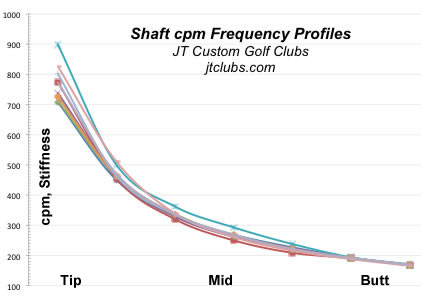MEASURING SHAFT STIFFNESS
SHAFT FLEX. The EI and cpm curves shown below illustrate two alternative measurements of shaft flex, or stiffness. The data are for 8 different models of lightweight (50-60 g) shafts rated at the same butt flex by their manufacturers. The increased detail in the distribution of stiffness variations through the length of a shaft as revealed by EI analysis refines our understanding of how a shaft can respond to the changing forces that develop during a golfer’s swing and allows for greater precision in shaft fitting. However, frequency measurements offer a simple way to classify shafts according to flex.
EI STIFFNESS ANALYSIS (E-I curves). A useful indicator of stiffness along a shaft’s length is EI, where E is a function of a material’s elastic stress/strain and I is a function of shaft wall thickness and diameter. These considerations are fundamental to the design of nearly all shafts in production today. We measure shaft EI with our own equipment. For Ei analysis, displacement pressure by a constant weight is measured along the shaft length in one-inch increments to reveal local stiffness variations that are engineered into the shaft. Variations in stiffness affect how a shaft will load in response to the changing forces that occur during a golf swing. EI analysis reveals essential details of flex design that help identify the best shaft for individual swing styles.

FREQUENCY ANALYSIS. (cpm curves). CPM frequency curves extend the general L,A,R,S,X flex classification through the length of the shaft. To generate a cpm curve, a shaft is clamped at different positions (usually 5-inch intervals) along the length of the shaft and a constant weight (usually 454 g) is clamped to the tip. The tip is displaced and released, and shaft oscillation in cpm is measured by a strain gauge frequency analyzer. The oscillation frequency in cpm at each point reflects the average stiffness over the length of the shaft beam from clamp to tip and the damping effect of the clamp on adjacent shaft regions. When the clamp is placed at the butt of the shaft, frequency measurement yields a value that represents its overall flex. Lack of resolution in stiffness distribution limits the usefulness of this method in shaft fitting.

WHAT’S UNDER THE PAINT? The EI curves below show three different shaft models with a similar butt flex but having significant stiffness variations designed into the mid and tip regions. These variations will yield substantial effects on ball flight. Consequently, “fitting” chart methods limited to matching (L,A,R,S,X) butt flex ratings with club head speed will miss critical shaft bending properties that make a major difference in how they perform with your swing. It helps to know what’s under the paint when fitting shafts to your clubs.

Shafts designed with stiffness inflection zones in specific regions along the shaft from tip to butt allow for increased precision in fitting. These zones act as hinge regions that affect swing parameters including launch angle, angle of attack, ball spin, ball trajectory shape, club head stability, and feel. Shafts are engineered to be actively involved in the performance of a club. Understanding how a shaft works in your swing matters.











